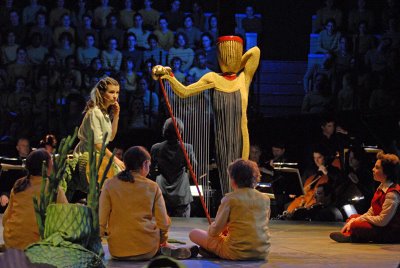
Last month, the
Théâtre du Châtelet presented a new opera that it commissioned from
Patrick Burgan (b. 1960), on the story of Peter Pan by J. M. Barrie. It was one of the final actions of the theater's departing director,
Jean-Pierre Brossmann. I read a review by Marie-Aude Roux (
"Peter Pan" se déploie au Théâtre Zingaro, May 27) for
Le Monde (my translation and links added):
Other directors would have ended with a heavyweight of the lyric repertory or on an egotistic, provocative note. Brossmann prefers something unheard of: the creation of a work of contemporary music, sung and acted principally by children, and presented outside the Châtelet's walls, at Bartabas's Théâtre Zingaro. Perhaps because the imaginary world of a director defending certain artistic principles is not one of the themes common to the lyric stage.
The imaginary kingdom of Patrick Burgan, centered on the feminine role of Wendy, develops "three simultaneous and interactive worlds." That of today, where Wendy as a grandmother recites the story of her adventures to her granddaughter Lucy (Marie-Christine Barrault is the sort of nutty and kind granny we love); the world of the past, where the young Wendy lives between her fighting parents and a dead younger brother; and the surreal world of Peter Pan, by far the most present on the stage.
Conceived as a helix, the set -- the city of London in trompe-l'œil - unrolls around the island, shown at the center of things as on an old map. From the corridors of the imagination, where normally the horses charge forth at a gallop, fairies and sirens rise up, Indians, pirates, and wild beasts. The sets and staging of Isabelle Partiot-Pieri are somber and very simple, effective at evoking the fantastic, like the large illuminated blinking alarm clock that signals the presence of Hook's enemy, the crocodile. [...]
The child soloists are for the most part of the age of their roles. They are at ease on stage and vocally, which is hardly surprising when you learn that they were prepared by Scott Alan Prouty. As for the singers, we would single out notably Gaële Le Roi's delicate and vibrant Tinkerbell (Fée Clochette), utterly graceful and with sophisticated flights into her very high range. The score is solidly stitched together, borrowing from Stravinsky's marches (L'Histoire du soldat) and from the Ravelian sonorities of L'Enfant et les sortilèges.
Some 450 students from the
Académie de Paris took part in the performances. Burgan wrote his own libretto for this opera, which was a world premiere. You can see a few pictures
here. I think that Washington National Opera's excellent
Opera Camp for Kids should consider trying to bring this opera to Washington. Mini-Critic and I loved their performance of
Brundibár last summer, and we are looking forward to their staging of
Dream of the Pacific this summer. If you look at the picture above, those are children on stage and a house full of schoolchildren watching and listening. That
Peter Pan is at least partially about helping children find themselves artistically is dramatized so beautifully in the recent film
Finding Neverland, on the life of J. M. Barrie. If you have not seen it yet, run do not walk to Netflix.
 Last month, the Théâtre du Châtelet presented a new opera that it commissioned from Patrick Burgan (b. 1960), on the story of Peter Pan by J. M. Barrie. It was one of the final actions of the theater's departing director, Jean-Pierre Brossmann. I read a review by Marie-Aude Roux ("Peter Pan" se déploie au Théâtre Zingaro, May 27) for Le Monde (my translation and links added):
Last month, the Théâtre du Châtelet presented a new opera that it commissioned from Patrick Burgan (b. 1960), on the story of Peter Pan by J. M. Barrie. It was one of the final actions of the theater's departing director, Jean-Pierre Brossmann. I read a review by Marie-Aude Roux ("Peter Pan" se déploie au Théâtre Zingaro, May 27) for Le Monde (my translation and links added):
No comments:
Post a Comment